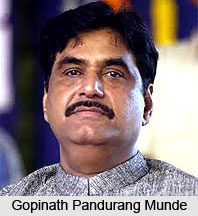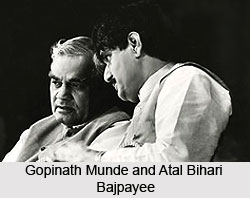 Gopinath Munde, formally known as Gopinath Pandurang Munde, was a famous Indian politician from Bharatiya Janata Party. He was the honorary member in Maharashtra Legislative Assembly for Five terms in 1980-1985, 1990-2009. He also acted as the Leader of Opposition in Maharashtra Legislative Assembly during 1992-1995. Gopinath Munde was elected to 15th Lok Sabha in 2009. He served as the Deputy Leader of the BJP in the Lok Sabha.
Gopinath Munde, formally known as Gopinath Pandurang Munde, was a famous Indian politician from Bharatiya Janata Party. He was the honorary member in Maharashtra Legislative Assembly for Five terms in 1980-1985, 1990-2009. He also acted as the Leader of Opposition in Maharashtra Legislative Assembly during 1992-1995. Gopinath Munde was elected to 15th Lok Sabha in 2009. He served as the Deputy Leader of the BJP in the Lok Sabha.
Early Life of Gopinath Munde
Gopinath Pandurang Munde was born on December 12, 1949 to Pandurang Munde and Limbabai Munde in a middle class Vanjari family of farmers. He was born in Parali in Maharashtra. Gopinath Pandurang Munde attended a government primary school, in Nathra village in Beed district. In his childhood days, he attended his classes in school under the tree. He did his higher education from Zilla Parishad School, in Parali. He graduated from a college in Ambejogai in Commerce subject. Gopinath Pandurang Munde was third child in the family of farmers. He was followed by younger brothers, Manikrao and Venkatrao.
Political Life of Gopinath Munde
Gopinath Pandurang Munde came into limelight of regional politics when he met Pramod Mahajan, a friend and colleague in the college. Finally, Gopinath Munde became actively involved in the Akhil Bharatiya Vidyarthi Parishad, which is the student wing of Janta Party.
Actively participated in student politics, he took part in the agitation against the state of emergency imposed by the Prime Minister Indira Gandhi. At that time he was imprisoned in the Nashik Central Jail until it was lifted. A year later, in the year 1971, he became associated with the campaign of the Bharatiya Jana Sangha candidate in the Lok Sabha election in the Beed constituency.

The turning point of the political career of Gopinath Pandurang Munde was, however, the Rashtriya Swayamsevak Sangh`s Shiksha Varga (Training Camp) held in Pune that year. He soon became the Sambhajinagar Mandal Karyavah looking after half a dozen shakhas of the Rashtriya Swayamsevak Sangh (RSS).
Later, Gopinath Pandurang Munde was made a member of the Executive Committee of the RSS`s regional base. The Janata Party by this time had split and the Bharatiya Janata Party was founded by the leaders the erstwhile Bharatiya Jana Sangha that had come into existence.
Gopinath Pandurang Munde was made the President of the Maharashtra unit of the BJP`s youth wing, Bharatiya Janata Yuva Morcha. Gopinath Pandurang Munde was Leader of Opposition in Maharashtra Vidhan Sabha from 12 December 1991 to14 March 1995. Gopinath Munde was sworn in as the Deputy Chief Minister of Maharashtra when Mr. Manohar Joshi led government took over the regime of the state on 14th March 1995. Gopinath Munde was member of 15th Lok Sabha (2009-2014) and represented Beed constituency. After the massive victory in 2014 Lok Sabha election, he was sworn as the Minister of Rural Development in Narendra Modi`s Cabinet. From his own constituency also, Gopinath Munde defeated NCP`s Suresh Dhas.
Personal Life of Gopinath Munde
Gopinath Mude married Pradnya, who was the sister of Pramod Mahajan, another BJP leader. Gopinath Munde, a diabetic patient died in the morning of 3rd June 2014 following a road accident in New Delhi. The convoy of Munde met with an accident in the Moti Bagh area of South Delhi, which is near Delhi airport.




















